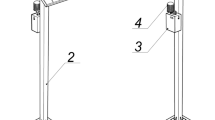Abstract
To solve the problem of relatively low efficiency in most of nowadays solar panels, this paper proposes a new solution by diagnosing and optimizing solar panel installations. Dr. Solar, a sensor-based device, acquires information on solar radiation, geographical position, inclination, roll, panel temperature, and ambient temperature and humidity. The sensor-based device is mounted to the solar panel for a few days while collecting data. The cloud-based service gathers information from the inverter while the device is moved to other installations. Combined with the data of power generation from the inverter, a cloud service is offered for processing and analyzing the data to maximize power production by adjusting the panel installation. During several short-term experiments in different places, Dr. Solar provided reliable data for analysis on the cloud platform, and a web interface was developed to calculate power production. The solution has increased photovoltaic panels’ efficiency by optimizing adjustments to the panel's physical position (tilt and angle). The paper describes the sensor-based device, the cloud service, and the algorithms used.
Access this chapter
Tax calculation will be finalised at checkout
Purchases are for personal use only
Similar content being viewed by others
References
SolarPower Europe: Global Market Outlook for Solar Power 05.2022. https://api.solarpowereurope.org/uploads/Solar_Power_Europe_Global_Market_Outlook_report_2022_2022_V2_07aa98200a.pdf
University of Michigan: Photovoltaic Energy Factsheet. https://css.umich.edu/publications/factsheets/energy/photovoltaic-energy-factsheet. Last accessed 19 Oct 2022
Dash, P.K., Gupta, N.C.: Effect of temperature on power output from different commercially available photovoltaic modules. Int. J. Eng. Res. Appl. 5(1), 148–151 (2015)
Köntges, M., Kurtz, S., Packard, C., Jahn, U., Berger, K.A., Kato, K.: Performance and reliability of photovoltaic systems subtask 3.2: Review of failures of photovoltaic modules: IEA PVPS task 13: external final report IEA-PVPS. IEA. ISBN 978-3-906042-16-9 (2014)
Amajama, J., Oku, D.E.: Effect of relative humidity photovoltaic panels’ output and solar illuminance/intensity. J. Sci. Eng. Res. 3(4), 126–130 (2016)
Panjwani, M.K., Panjwani, S.K., Mangi, F.H., Khan, D., Meicheng, L.: Humid free efficient solar panel. In: 2nd International Conference on Energy Engineering and Smart Materials: ICEESM, vol. 1884, no. 1 (2017)
Teimourzadeh, S., Tor, O.B., Cebeci, M.E., Bara, A., Oprea, S.V.: A three-stage approach for resilience-constrained scheduling of networked microgrids. J. Mod. Power Syst. Clean Energy 7(4), 705–715 (2019)
Cui, C., Zou, Y., Wei, L., Wang, Y.: Evaluating combination models of solar irradiance on inclined surfaces and forecasting photovoltaic power generation. IET Smart Grid 2, 123–130 (2019)
Ciulla, G., Lo Brano, V., Moreci, E.: Forecasting the cell temperature of PV modules with an adaptive system. Int. J. Photoenergy 2013, 1–10 (2013). https://doi.org/10.1155/2013/192854
Boyson, W.E., Galbraith, G.M., King, D.L., Gonz, S.: Performance Model for Grid-Connected Photovoltaic Inverters. Sandia National Laboratories (SNL), Albuquerque, NM, and Livermore, CA (2007)
Acknowledgments
This work was part of the project “Cloud-based analysis and diagnosis platform for photovoltaic (PV) prosumers” supported by the Manu Net scheme Grant number MNET20/NMCS-3779 and funded through the Research Council of Norway Grant number 322500, UEFISCDI – Executive Agency for Higher Education (Romania): Research, Development and Innovation Fund, contract no. 215/2020, and TÜBİTAK ARDEB 1071 (Turkey): Support Program for Increasing Capacity to Benefit from International Research Funds and Participation in International R&D Cooperation (Project No: 120N838).
Author information
Authors and Affiliations
Corresponding author
Editor information
Editors and Affiliations
Rights and permissions
Copyright information
© 2023 The Author(s), under exclusive license to Springer Nature Switzerland AG
About this paper
Cite this paper
Berntzen, L., Teimourzadeh, S., Anghelita, P., Ming, Q., Ursu, V. (2023). A Sensor-Based Unit for Diagnostics and Optimization of Solar Panel Installations. In: Papadaki, M., Rupino da Cunha, P., Themistocleous, M., Christodoulou, K. (eds) Information Systems. EMCIS 2022. Lecture Notes in Business Information Processing, vol 464. Springer, Cham. https://doi.org/10.1007/978-3-031-30694-5_9
Download citation
DOI: https://doi.org/10.1007/978-3-031-30694-5_9
Published:
Publisher Name: Springer, Cham
Print ISBN: 978-3-031-30693-8
Online ISBN: 978-3-031-30694-5
eBook Packages: Computer ScienceComputer Science (R0)




